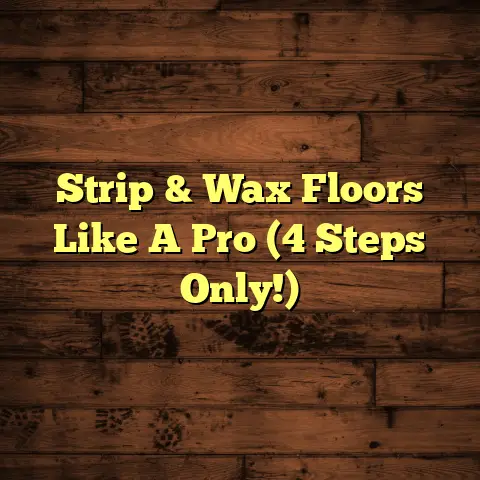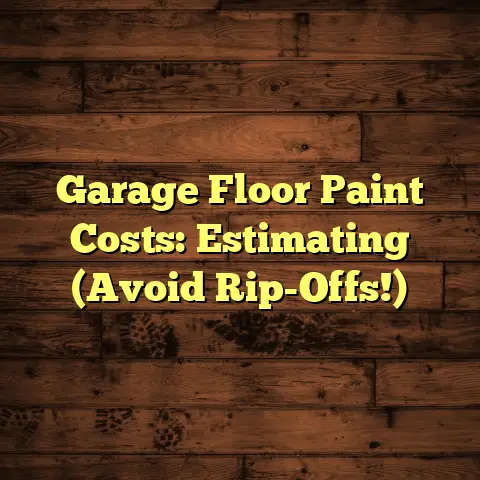Fill Void Under Floating Floor? (5 Minute Fix Needed!)
I’ve been a flooring contractor for over 15 years, and let me tell you, that sound is a common issue.
But don’t worry, you’re not alone, and more importantly, it’s
often a quick fix.
I’m going to walk you through how to tackle
that void under your floating floor in what might feel like just
five minutes.
Trust me, it’s simpler than you think!
Section 1: Understanding Floating Floors
What is a Floating Floor?
So, what exactly is a floating floor?
Well, unlike traditional
floors that are nailed or glued down, a floating floor “floats”
above the subfloor.
Think of it like a puzzle where the pieces interlock but aren’t attached to the base beneath.
These floors typically come in materials like:
-
Laminate: A synthetic product made of layers fused together. It’s durable and budget-friendly.
Engineered Wood: Real wood veneer over a plywood or fiberboard core.
Offers the look of hardwood with added stability.-
Luxury Vinyl Plank (LVP): A waterproof and highly durable synthetic option that mimics the look of wood or tile.
The beauty of floating floors lies in their ease of installation
and versatility.
They’re a popular choice for DIYers because you
don’t need nails, glue, or a ton of specialized tools.
Here’s a quick comparison table:
How Floating Floors Work
Floating floors are designed with a tongue-and-groove system or a
click-lock mechanism.
This allows the planks or tiles to snap
together, creating a unified surface.
But here’s the kicker: they’re not directly attached to the
subfloor.
This “floating” design allows the floor to expand and
contract with changes in humidity and temperature.
That’s where expansion gaps come in.
These are small spaces left
around the perimeter of the room (usually about ¼ inch).
They’re crucial because they give the floor room to move without
buckling or warping.
Without these gaps, you’re asking for trouble
– like those annoying voids we’re about to fix!
Section 2: Identifying the Problem
Signs of a Void Under Your Floating Floor
Okay, let’s get down to the detective work.
How do you know if
you have a void under your floating floor?
Here are some telltale
signs I’ve seen over the years:
Creaking Sounds: This is the most obvious.
If you hear creaks or squeaks when you walk over a specific area, it’s a good sign there’s a gap underneath.Bouncing Sensation: Does the floor feel a little bouncy or spongy in certain spots?
That’s another red flag.Gaps Between Planks: Check for visible gaps between the planks or tiles.
This can indicate that the floor is sinking in certain areas.Uneven Surfaces: Run your hand across the floor.
Do you feel any dips or raised areas?
This could be a sign of an uneven subfloor or voids underneath.-
Movement When Stepped On: If you step on a section of the floor and it noticeably moves or shifts, there’s likely a void.
Causes of Voids
So, what causes these pesky voids in the first place?
Here are a
few common culprits:
Humidity Changes: Wood and wood-based products expand and contract with changes in humidity.
This can lead to gaps and voids over time.According to the Forest Products Laboratory, wood can swell or shrink up to 5% in width depending on humidity levels.
(Source: USDA Forest Service).Improper Installation: This is a big one.
If the subfloor wasn’t properly leveled before installation, voids are almost guaranteed to appear.-
Settling of the Foundation: Over time, foundations can settle, creating unevenness in the subfloor.
-
Subfloor Damage: Water damage, rot, or insect infestations can weaken the subfloor, leading to voids.
Inadequate Underlayment: The underlayment provides a cushion and helps to level out minor imperfections in the subfloor.
If it’s too thin or not properly installed, voids can develop.
Moisture and temperature fluctuations are the silent enemies of
floating floors.
They cause the materials to expand and contract,
which can eventually lead to gaps and voids.
That’s why it’s crucial to maintain a consistent indoor climate and address any moisture issues promptly.
Section 3: Tools and Materials Needed for the Fix
Alright, time to gather our gear.
For this quick fix, you won’t
need a whole arsenal of tools.
Here’s what I recommend:
Essential Tools
-
Hammer: For gently tapping planks into place.
-
Tapping Block: This protects the edges of your flooring while you’re hammering.
-
Pry Bar: To carefully lift planks if you need to remove a section.
-
Utility Knife: For scoring and cutting materials.
-
Level: To ensure your floor is even.
-
Measuring Tape: For accurate measurements.
-
Drill with Wood Bits: If you need to create access holes for injecting filler.
Materials for Filling Voids
Now, let’s talk about what to use to fill those voids.
Here are a
few options I’ve used with success:
Foam Backer Rod: This is a flexible foam that comes in various diameters.
It’s great for filling larger gaps before applying other materials.Self-Leveling Compound: This is a liquid that you pour into the void.
It spreads out and hardens, creating a level surface.
Be careful, this can get messy!-
Wood Shims: Thin, tapered pieces of wood that you can slide under the floor to provide support.
-
Construction Adhesive: For securing shims or other fillers in place.
Expanding Foam: This is a spray foam that expands to fill voids.
Use it sparingly, as it can expand too much and lift the floor.
The best material depends on the size of the void and the type of
floating floor you have.
For small voids, shims or foam backer rod
might be sufficient.
For larger voids, self-leveling compound is
usually the way to go.
Section 4: Step-by-Step Guide to Filling the Void
Okay, time to get our hands dirty!
Here’s a step-by-step guide to
filling that void under your floating floor.
Preparation Steps
Identify the Void: Pinpoint the exact location of the void.
Mark it with tape so you don’t lose track.-
Assess the Situation: Determine the size of the void and the type of material you’ll need.
Remove a Section of the Floor (If Necessary): If the void is not accessible from the edge of the room, you may need to remove a section of the floor.
Use a pry bar and tapping block to carefully lift the planks, starting from the wall.Clean the Area: Remove any debris, dust, or dirt from the void.
A clean surface will ensure better adhesion of the filler.-
Safety First: Wear safety glasses and gloves to protect yourself from dust and chemicals.
The 5-Minute Fix Process
Alright, let’s get to the heart of the matter – the actual fix!
Here’s how to fill that void in (hopefully) just five minutes:
Insert Filler Material: Depending on the size of the void, insert foam backer rod, wood shims, or a combination of both.
Use construction adhesive to secure the materials in place.Apply Leveling Compound (If Necessary): If the void is large or uneven, apply a self-leveling compound.
Follow the manufacturer’s instructions carefully.
Pour the compound into the void and let it spread out evenly.-
Ensure Even Distribution: Use a trowel or putty knife to smooth out the leveling compound and ensure it’s evenly distributed.
Let it Dry: Allow the leveling compound to dry completely according to the manufacturer’s instructions.
This may take several hours or even overnight.
Reinstalling the Floor
-
Replace the Flooring: Carefully replace the flooring section you removed, aligning the planks and tapping them into place with a hammer and tapping block.
Check for Level: Use a level to ensure the floor is even.
If necessary, add more shims or leveling compound to adjust the height.-
Secure the Floor: Once the floor is level and in place, apply pressure to the area to ensure it’s securely attached.
-
Clean Up: Remove any excess adhesive or leveling compound from the surface of the floor.
Section 5: Post-Repair Maintenance
Congratulations!
You’ve successfully filled the void under your
floating floor.
But the job’s not quite done yet.
Here’s how to
keep your floor in tip-top shape:
Monitoring Your Floors
Listen for Creaks: Keep an ear out for any new creaks or squeaks.
This could indicate that the void is reappearing.-
Check for Gaps: Regularly inspect the floor for gaps between planks or tiles.
-
Feel for Unevenness: Run your hand across the floor to check for any dips or raised areas.
Preventative Measures
Control Humidity: Maintain a consistent indoor humidity level to prevent the floor from expanding and contracting too much.
A humidifier or dehumidifier can help.According to the EPA, maintaining indoor humidity between 30-50% is ideal for both comfort and preventing mold growth.
(Source: EPA.gov).-
Proper Installation: Ensure that the subfloor is properly leveled and prepared before installing the floating floor.
-
Use Quality Underlayment: Invest in a good quality underlayment to provide cushioning and help level out minor imperfections.
Regular Maintenance: Sweep or vacuum the floor regularly to remove dirt and debris.
Clean spills immediately to prevent water damage.
Conclusion
Recap of the Quick Fix
So, there you have it!
We’ve covered everything you need to know
to identify and fix that annoying void under your floating floor.
Remember:
- Floating floors are great but need a little TLC.
- Voids are often caused by humidity, poor installation, or settling.
- A few simple tools and materials can work wonders.
- Prevention is key to keeping your floors in good shape.
Final Thoughts
Don’t let a little hollow sound ruin your day.
With a bit of
effort and the right know-how, you can restore the comfort and
beauty of your home.
Trust me, there’s nothing quite like the feeling of walking across
a solid, sound floor.
So go ahead, tackle that void, and enjoy
your beautiful, comfortable living space!





